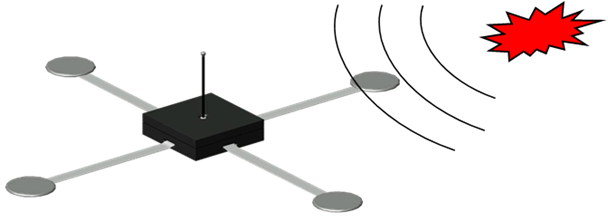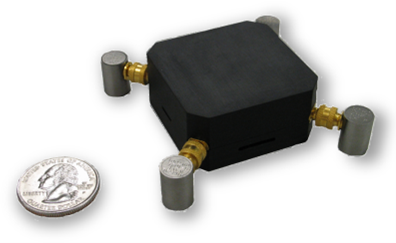Invocon developed the Distributed Impact Detection System (DIDS) as a Phase 2 SBIR contract from the NASA Langley Research Center. Impact detection and characterization on manned spacecraft has been an elusive goal due to the transitory nature of the detectable high-frequency signals. The approach for this effort is to use large numbers of wireless, self-powered, miniaturized, “stick on” piezoelectric sensory nodes. Each node will continuously monitor an accelerometer, acoustic emission sensor, or PZT element for an impact event, such as the foam impact that caused the Columbia tragedy or a micro-meteor impact. The figure below depicts the operating concept for DIDS.

When a programmable threshold is exceeded by an impact event, an extremely low-latency signal acquisition circuit will capture the event as a digital waveform for post-processing and impact characterization. The innovative signal conditioning circuit design is capable of operation in the micro-watt range on average while constantly maintaining the capability to process and acquire high-frequency acoustic signals in the hundred kilohertz range. DIDS employs multiple modes operating at different power levels in order to maintain extremely low average power consumption.
These modes include:
- Trigger mode: DIDS’ primary mode of operation
- Data Mode: DIDS take a snapshot of data
- Processing Mode: DIDS processes or stores the data
- RF Transmit Mode: DIDS sends an alert that an event has occurred. RF is also used for configuring the sensor units and downloading data.
These power levels can provide operating lifetimes of years on a single battery, or unlimited operation from scavenged power sources. The standard 1mAh battery provides up to 1.9 years of life.

Acoustic Emission Transducers
Figure 2 shows a DIDS sensor unit along with four Acoustic Emission transducers. The transducer array is designed in combination with the extremely low-latency trigger capability to insure that the entire trigger event is captured.
Accelerometer and Ultrasonic Transducers
In addition to A/E sensor, Invocon has interfaced DIDS with both accelerometers and ultrasonic transducers. The accelerometer unit looks similar to the A/E unit in Figure 2. However, it typically has larger transducers due to the structure of accelerometers. It was delivered to NASA for comparative testing with Invocon’s Wing Leading Edge Impact Detection System. The ultrasonic sensor unit is shown in Figure 3. It includes four directional transducers and was delivered to NASA for testing as a leak detection system.
